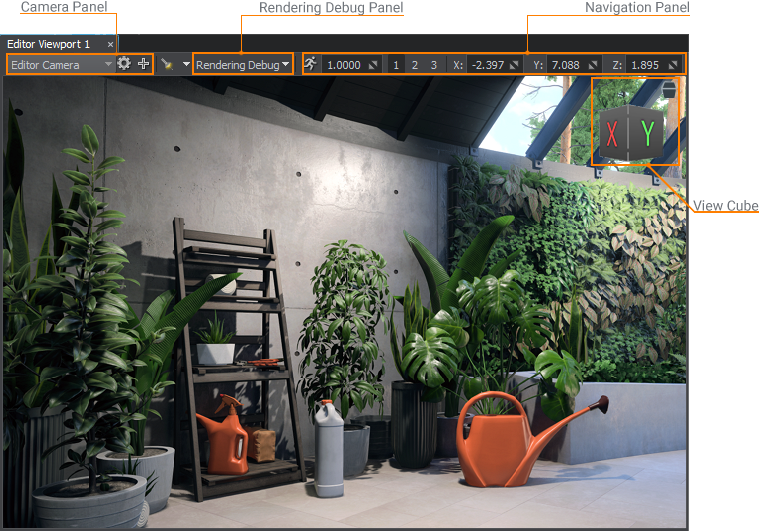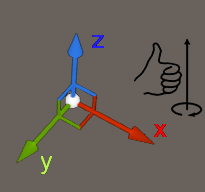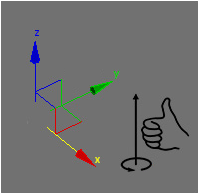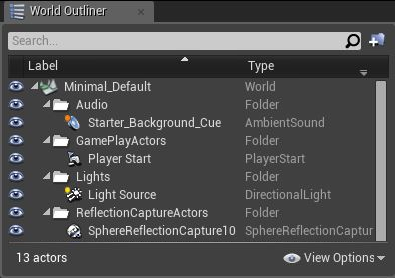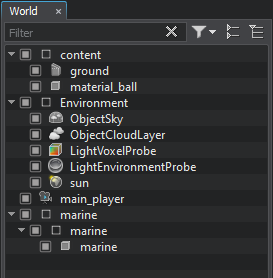Переход на UNIGINE с Unreal Engine
This section gives a brief overview of UNIGINE from an Unreal Engine user's perspective and provides basic information to help you transfer your Unreal Engine experience to UNIGINE.Этот раздел дает краткий обзор UNIGINE с точки зрения пользователя Unreal Engine и предоставляет основную информацию, которая поможет вам перенести ваш опыт работы с Unreal Engine на UNIGINE.
Quick GlossaryБыстрый глоссарий#
This chapter matches common Unreal Engine terms on the left and their UNIGINE equivalents (or rough equivalent) on the right. UNIGINE keywords are linked directly to related articles to provide you with more in-depth information.В этой главе сопоставляются общие термины Unreal Engine слева и их эквиваленты в UNIGINE (или приблизительный эквивалент) справа. Ключевые слова UNIGINE напрямую связаны со связанными статьями, чтобы предоставить вам более подробную информацию.
| Category | Unreal Engine | UNIGINE |
|---|---|---|
| Editor UI | World Outliner | World Nodes Hierarchy window |
| Details Panel | Parameters window | |
| Content Browser | Asset Browser window | |
| Viewport | Editor Viewport | |
| Scene | Level | World |
| Gameplay Types | Actor, Pawn | Node |
| Blueprint Class | NodeReference + Component System | |
| Meshes | Static Mesh | Static Mesh, Dynamic Mesh |
| Skeletal Mesh | Skinned Mesh | |
| Effects | Effect, Particle, Cascade | Particle System |
| Game UI | UMG (Unreal Motion Graphics) | GUI |
| Materials | Material, Material Editor | Base Material |
| Material Instance | User Material | |
| Programming | C++ | C++ / C# |
| Blueprint | UnigineScript | |
| Physics | Line Trace | getIntersection |
| Primitive Component | Rigid Body | |
| Collision | Shape | |
| Physics Constraint | Joint | |
| Animation | Sequencer | Tracker |
Project and SDK ManagementУправление проектами и SDK#
As an Unreal Engine user, you are accustomed to use Epic Games Launcher — the application that streamlines the way you find, download and manage your projects and installations. In addition to it, you can manage your projects directly via Unreal Editor: create a new project and switch between the existing ones.Как пользователь Unreal Engine вы привыкли использовать Epic Games Launcher - приложение, которое упрощает поиск, загрузку и управление вашими проектами и установками. В дополнение к этому вы можете управлять своими проектами напрямую через Unreal Editor: создавать новый проект и переключаться между существующими.
UNIGINE SDK Browser is the first step to start working with UNIGINE Engine. This application incorporates all project-related tasks and enables you to manage your projects and installed SDKs, as well as gives you access to the samples and the knowledge base.UNIGINE SDK Browser - это первый шаг к началу работы с UNIGINE Engine. Это приложение включает в себя все задачи, связанные с проектом, и позволяет вам управлять своими проектами и установленными SDK, а также предоставляет вам доступ к примерам и базе знаний.
UNIGINE provides several programming workflows, to easily adapt your programming experience in Unreal Engine it is recommended for you to use the C++ Component System. Creating a project using this workflow in SDK Browser is done as follows:UNIGINE предоставляет несколько рабочих процессов программирования , чтобы легко адаптировать ваш опыт программирования в Unreal Engine, вам рекомендуется использовать C ++ Component System . Создание проекта с использованием этого рабочего процесса в SDK Browser выполняется следующим образом:
- Click Create New in My Projects section;Нажмите Create New в разделе My Projects;
- Among other options, choose C++ (Visual Studio 2015+) project type in the API + IDE field;Среди других опций выберите тип проекта C++ (Visual Studio 2015+) в поле API + IDE;
- If you want to make the project compatible with supported VR headsets, select the VR option in the Template field. This will enable required plugins and add template assets (more about VR-compatibility); Если вы хотите сделать проект совместимым с поддерживаемыми гарнитурами VR, выберите опцию VR в поле Template. Это позволит включить необходимые плагины и добавить ассеты шаблона (подробнее о VR-совместимости );
- Check the Component System feature if it isn't enabled yet.Отметьте функцию Component System, если она еще не включена.
- Click Create New Project.Щелкните Create New Project.
- Upon completion, click Open Editor to run UnigineEditor; click Open Code IDE to open the project's source code via the default IDE.По завершении щелкните Open Editor, чтобы запустить UnigineEditor; щелкните Open Code IDE, чтобы открыть исходный код проекта через IDE по умолчанию.
Editor InterfaceИнтерфейс редактора#
Below you can see interfaces of the Unreal Editor and UnigineEditor. Interface elements in the images are color-coded to indicate common functionality. Each element has a label to show UNIGINE's equivalent. The layout of UnigineEditor is fully customizable by resizing, dragging and dropping the tabbed windows.Ниже вы можете увидеть интерфейсы файлов Unreal Editor и UnigineEditor. Элементы интерфейса на изображениях имеют цветовую кодировку для обозначения общих функций. Каждый элемент имеет метку для отображения эквивалента UNIGINE. Макет UnigineEditor полностью настраиваемый путем изменения размера, перетаскивания окон с вкладками.
To learn more about the UnigineEditor interface, read this article.Чтобы узнать больше об интерфейсе UnigineEditor, прочтите эту статью .
ViewportsОкна просмотра (Viewports)#
Unreal Editor Viewports and Editor Viewports in UnigineEditor are very much alike. You can use as many Editor Viewports as you need.Unreal Editor Viewports и Editor Viewports в UnigineEditor очень похожи. Вы можете использовать столько окон просмотра Editor , сколько вам нужно.
By default, an Editor Viewport renders its own Editor Camera view, and you can switch to another camera present in the scene and control it the same way as you pilot a CameraActor in UE.По умолчанию Viewport Editor отображает собственное представление Editor Camera, и вы можете переключиться на другую камеру , присутствующую в сцене, и управлять ею так же, как вы пилотируете CameraActor в UE.
Navigation inside Editor Viewports is pretty much the same as in UE Viewports. However, get familiar with Scene Navigation so as not to miss details.Навигация внутри видовых экранов редактора почти такая же, как и в видовых экранах UE. Однако ознакомьтесь с навигацией по сценам , чтобы не упустить детали.
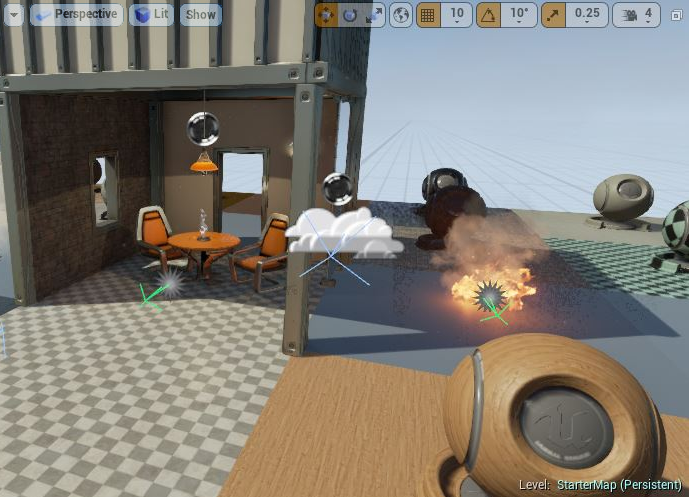
|
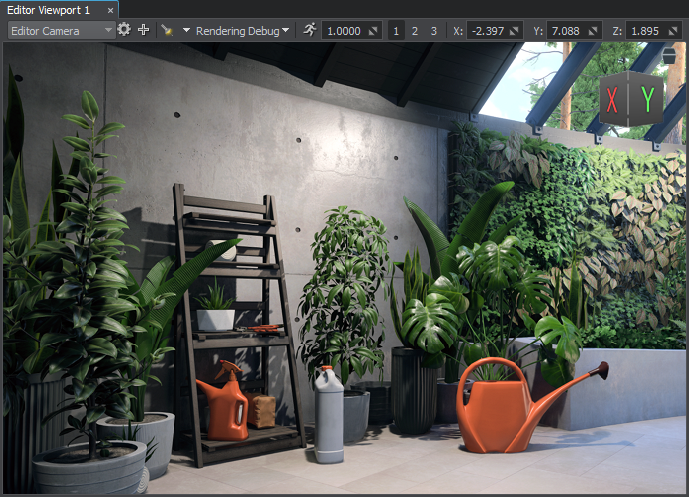
|
|
Unreal Editor Viewport
|
UNIGINE Editor Viewport
|
|
|
|
You can use:Вы можете использовать:
- Camera panel to switch between cameras and configure the current one.Camera panel для переключения между камерами и настройки текущей.
- Rendering Debug to display the contents of rendering buffers the same way as using the Buffer Visualization Mode in UE4.Rendering Debug для отображения содержимого буферов рендеринга так же, как при использовании Buffer Visualization Mode в UE4.
- Navigation panel to quickly set up and switch between camera speed presets and change the camera position.Navigation panel для быстрой настройки и переключения между предустановками скорости камеры и изменения положения камеры.
- ViewCube to switch between the perspective/orthographic projections and control orientation of the camera.ViewCube для переключения между перспективной / ортогональной проекцией и управлением ориентацией камеры.
Also, a set of switchers is available globally in the top toolbar:Также, набор переключателей доступен глобально на верхней панели инструментов:

- Helpers panel provides quick access to auxiliary visualizers, such as icons, gizmos and wireframes. Панель Helpers обеспечивает быстрый доступ к вспомогательным визуализаторам, таким как значки, штуковины и каркасы.
- Precompile All Shaders toggle is used for Forced Shaders Compilation Переключатель Precompile All Shaders используется для принудительной компиляции шейдеров
- Animation toggle Animation toggle
- Physics toggle Physics toggle
- Audio toggle Audio переключить
Playing and SimulatingИгра и моделирование#
You are accustomed that Unreal Editor has the Play In Editor (PIE) mode launching the game in the current Viewport and being representative of your final build. You can also play in other modes and use the Simulate In Editor (SIE) mode to preview blueprints logic, animation and physics simulation.Вы привыкли, что Unreal Editor имеет режим Play In Editor (PIE), запускающий игру в текущем окне просмотра и представляющий вашу окончательную сборку. Вы также можете играть в других режимах и использовать режим Simulate In Editor (SIE) для предварительного просмотра логики чертежей, анимации и моделирования физики.

In UNIGINE, you can enable animation and physics simulation using the toggles in the top toolbar. You can open the Engine viewport (menu: Windows -> Engine Viewport) where you can pilot the current Main Player.В UNIGINE вы можете включить анимацию и моделирование физики , используя переключатели на верхней панели инструментов. Вы можете открыть окно просмотра Engine (меню: Windows -> Engine Viewport), где вы можете управлять текущим Main Player.
To check application logic you will need to run an instance of the current compiled binary of the application via any of the following ways:Чтобы проверить логику приложения, вам нужно будет запустить экземпляр текущего скомпилированного двоичного файла приложения любым из следующих способов:
-
Via SDK Browser by clicking Run:
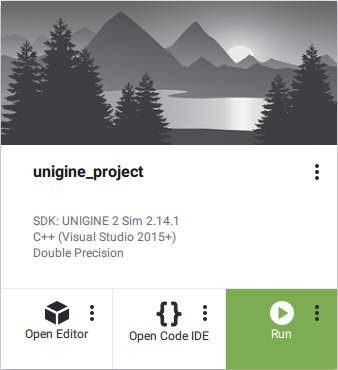
You can also run the application with custom settings by clicking an ellipsis under the Run button (e.g. choose the Debug binaries).You can also run the application with custom settings by clicking an ellipsis under the Run button (e.g. choose the Debug binaries).
You can also run the application with custom settings by clicking an ellipsis under the Run button (e.g. choose the Debug binaries). Через браузер SDK , нажав Run:
You can also run the application with custom settings by clicking an ellipsis under the Run button (e.g. choose the Debug binaries).Вы также можете запустить приложение с пользовательскими настройками , щелкнув многоточие под кнопкой Run (например, выберите двоичные файлы отладки).
-
By using the corresponding launcher created by default in the project folder:
-
 launch_debug — the launcher of the project's debug version.
launch_debug — the launcher of the project's debug version.
 launch_debug — the launcher of the project's debug version.
launch_debug — the launcher of the project's debug version.
-
 launch_release — the launcher of the project's release version.
launch_release — the launcher of the project's release version.
 launch_release — the launcher of the project's release version.
launch_release — the launcher of the project's release version.
 launch_debug — the launcher of the project's debug version.
launch_debug — the launcher of the project's debug version.
 launch_release — the launcher of the project's release version.
Используя соответствующий launcher, созданный по умолчанию в папке проекта:
launch_release — the launcher of the project's release version.
Используя соответствующий launcher, созданный по умолчанию в папке проекта:
-
 launch_debug — the launcher of the project's debug version.
launch_debug — the launcher of the project's debug version.
 launch_debug - лаунчер отладочной версии проекта.
launch_debug - лаунчер отладочной версии проекта.
-
 launch_release — the launcher of the project's release version.
launch_release — the launcher of the project's release version.
 launch_release - лаунчер релизной версии проекта.
launch_release - лаунчер релизной версии проекта.
-
- By running the project directly from the IDE used.Запуская проект прямо из используемой IDE.
By default, the mouse cursor is grabbed when clicked at run time, providing camera movement control, press Esc to free the cursor. There are two ways to setup default Input Bindings (key states and the mouse behaviour):По умолчанию курсор мыши захватывается при нажатии во время выполнения, обеспечивая управление движением камеры, нажмите Esc, чтобы освободить курсор. Есть два способа установить привязки ввода по умолчанию (состояния клавиш и поведение мыши):
Output LogКонсоль#
As well as UE4, UNIGINE has the Console used for standard input, output and error logging. A set of console commands is provided.Как и UE4, UNIGINE имеет Console , используемую для стандартного ввода, вывода и регистрации ошибок. Предоставляется набор консольных команд .
It is available both in UnigineEditor and a running application. To open the Console window in the Editor, go to Windows -> Console menu:Он доступен как в UnigineEditor, так и в работающем приложении. Чтобы открыть окно консоли в редакторе, перейдите в меню Windows -> Console:
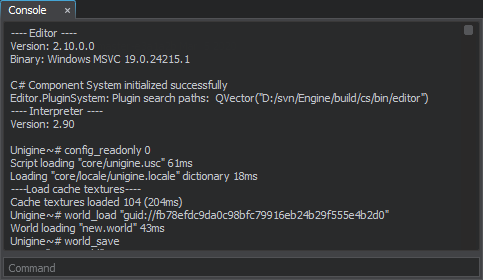
A built-in console is called by pressing the F1 key:Встроенная консоль вызывается нажатием клавиши grave accent (`):
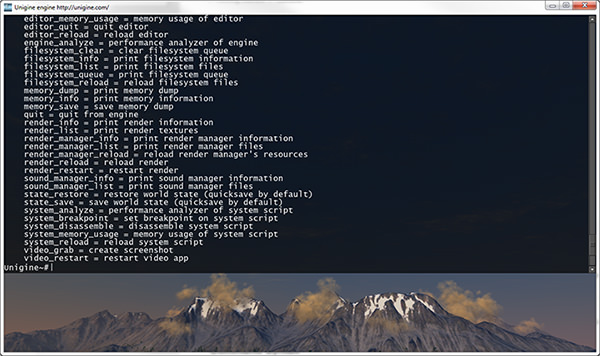
You can use it to print user messages from code.Вы можете использовать его для печати пользовательских сообщений из кода .
Packing a Final Build for PublishingФинальная сборка проекта для публикации#
In Unreal Engine, you got used to building your projects via the Editor. In UNIGINE, packing a final build is also done via UnigineEditor.В Unreal Engine вы привыкли создавать свои проекты через редактор. В UNIGINE финальная сборка проекта также выполняется через UnigineEditor.
Projects and FilesПроекты и файлы#
Directories and FilesКаталоги и файлы#
A project in UNIGINE, just like a UE project, is stored in its own folder, project settings are stored in the *.project file. There are various subfolders inside the project's folder, where your content and source files as well as various configuration files and binaries are stored. The most important are the data and source sub-folders.Проект в UNIGINE, как и проект UE, хранится в собственной папке, настройки проекта хранятся в файле *.project. Внутри папки проекта есть различные подпапки, в которых хранятся ваш контент и исходные файлы, а также различные файлы конфигурации и двоичные файлы. Наиболее важными являются подпапки data и source.
In UNIGINE, each project has a data folder. Similar to a UE project's Content folder, this is where your project's assets are stored. To import assets into your project, simply drop files into your project's data directory and they will be automatically imported and appear in the Asset Browser. The assets in the editor will update automatically as you make changes to the files using an external program.В UNIGINE у каждого проекта есть папка data. Подобно папке Content проекта UE, здесь хранятся ассеты вашего проекта. Чтобы импортировать ассеты в проект, просто перетащите файлы в каталог проекта data, и они будут автоматически импортированы и появятся в Asset Browser . Ассеты в редакторе обновляются автоматически, когда вы вносите изменения в файлы с помощью внешней программы.

The core folder contains the built-in core assets. These assets are read-only and available for every project by default.Папка core содержит встроенные основные ассеты. Эти ассеты доступны только для чтения и по умолчанию доступны для каждого проекта.
Supported File TypesПоддерживаемые типы файлов#
UNIGINE, like UE, supports the most commonly used file types and some specific ones:UNIGINE, как и UE, поддерживает наиболее часто используемые типы файлов и некоторые специфические :
| Типы ассетов | Поддерживаемые форматы |
|---|---|
| Геометрия | .fbx, .obj, .3ds, .dae, .glb/.gltf, .stp/.step, .igs/.iges, .brep, .stl |
| Текстуры | .png, .jpeg, .tif, .tga, .rgba, .psd, .hdr, .dds, and more |
| Звук и видео | .wav, .mp3, .oga/.ogg, .ogv |
| Шрифты | .ttf |
Bringing Your Assets from Unreal EngineПеренос ваших ассетов из Unreal Engine#
Unreal Engine assets (.uasset) are not supported for import by UNIGINE. Use the source content files you have used in your UE projects or export assets in one of formats supported by UNIGINE.Ассеты Unreal Engine (.uasset) не поддерживаются для импорта UNIGINE. Используйте исходные файлы содержимого, которые вы использовали в своих проектах UE, или экспортируйте ассеты в один из форматов, поддерживаемых UNIGINE.
Meshes Меши
You can import assets you used in UE to UNIGINE: export your mesh as an FBX model and import it to UNIGINE checking the required import options depending on the model.Вы можете импортировать ассеты, которые вы использовали в UE, в UNIGINE: экспортировать вашу сетку как модель FBX и импортировать в UNIGINE, проверяя необходимые параметры импорта в зависимости от модели.
Materials Материалы
Similar to other engines, UNIGINE works with PBR materials. Moreover, UNIGINE supports both Metalness and Specular workflows and has a rich out-of-the-box library of materials that can be used to create almost any material. Therefore, materials created for the model in UE can be re-created in UNIGINE using mesh_base material, the base material in UNIGINE used for physically based materials.Подобно другим движкам, UNIGINE работает с материалами PBR . Более того, UNIGINE поддерживает рабочие процессы Metalness и Specular и имеет богатую готовую библиотеку материалов, которую можно использовать для создания практически любого материала. Следовательно, материалы, созданные для модели в UE, могут быть воссозданы в UNIGINE с использованием материала mesh_base , базового материала в UNIGINE, используемого для физически обоснованных материалов.
Textures Текстуры
Textures can be imported as a part of a model or separately and then applied to a mesh. To import textures, you might have to do some adjustments in advance. For example, the Shading texture in UNIGINE stores the metalness, roughness, specular, and microfiber maps in its corresponding channels (RGBA), so you need to modify the texture using third-party software, such as GIMP or Photoshop, and then import it to UNIGINE.Текстуры можно импортировать как часть модели или отдельно, а затем применять к сетке. Чтобы импортировать текстуры , вам, возможно, придется заранее внести некоторые изменения. Например, текстура Shading в UNIGINE хранит карты металличности, шероховатости, отражения и микрофибры в своих соответствующих каналах (RGBA), поэтому вам необходимо изменить текстуру с помощью стороннего программного обеспечения, такого как GIMP или Photoshop, а затем импортировать ее. в UNIGINE.
Normal texture used in UE is compatible with UNIGINE, therefore you can import your normal textures to UNIGINE without any changes.Текстура Normal, используемая в UE, совместима с UNIGINE, поэтому вы можете импортировать свои обычные текстуры в UNIGINE без каких-либо изменений.
Animations Анимация
If you want to import a bone-animated model, export it from UE as an FBX file and enable the Import Animations option during the import to UNIGINE. You will also have additional options to finetune the import.Если вы хотите импортировать модель с анимацией костей, экспортируйте ее из UE в виде файла FBX и включите параметр Import Animations во время импорта в UNIGINE. У вас также будут дополнительные параметры для точной настройки импорта.
For more details, see import recommendations.Для получения дополнительных сведений см. рекомендации по импорту .
LevelsLevels#
The concept of 3D scene in both engines is the same. However, Unreal Engine and UNIGINE use different coordinate systems.Концепция 3D сцены в обоих движках одинакова. Однако Unreal Engine и UNIGINE используют разные системы координат.
| Unreal Engine | UNIGINE |
|---|---|
|
Separate 3D scenes are called Levels (also referred to as Maps).Отдельные 3D-сцены называются Levels (также называются Maps). UE uses a left-handed coordinate system where the vertical direction is usually represented by the +Z axis.UE использует левостороннюю систему координат, в которой вертикальное направление обычно представлено осью +Z. Axes and Directions: Оси и направления:
Positive rotation angle sets the rotation clockwise.Положительный угол поворота устанавливает вращение по часовой стрелке. File format: *.umapФормат файла: *.umap |
Separate 3D scenes are called Worlds.Отдельные 3D-сцены называются Worlds. UNIGINE uses a right-handed coordinate system where the vertical direction is usually represented by the +Z axis.UNIGINE использует правостороннюю систему координат, в которой вертикальное направление обычно представлено осью +Z. Axes and Directions: Оси и направления:
Positive rotation angle sets the rotation counterclockwise.Положительный угол поворота устанавливает вращение против часовой стрелки. File format: *.worldФормат файла: *.world |
To change the starting map of your project in UE4, you open Project Settings -> Maps & Modes and specify the default map for game and editor. In UNIGINE you specify the Default World of the project when creating a build (File -> Create Build). As for UnigineEditor and development builds, you can override the default world explicitly by running the project or the editor with custom settings:Чтобы изменить начальную карту вашего проекта в UE4, вы открываете Project Settings -> Maps & Modes и указываете карту по умолчанию для игры и редактора. В UNIGINE вы указываете Default World проекта при создании сборки (File -> Create Build). Что касается UnigineEditor и сборок для разработки, вы можете явно переопределить мир по умолчанию, запустив проект или редактор с пользовательскими настройками :
- In SDK Browser, click an ellipsis under the Run or Open Editor button;В браузере SDK щелкните многоточие под кнопкой Run или Open Editor;
-
In the Customize Run Options form that opens, specify the following startup command-line option in the Arguments field:
Shell-командыВ открывшейся форме Customize Run Options укажите следующий параметр командной строки запуска в поле Arguments:
-console_command "world_load your_world_name"Shell-команды-console_command "world_load your_world_name"
Scene ObjectsОбъекты сцены#
This section gives a brief description of basic scene objects in both engines as well as their basic similarities and differences.В этом разделе дается краткое описание основных объектов сцены в обоих движках, а также их основные сходства и различия.
| Unreal Engine | UNIGINE |
|---|---|
|
World OutlinerМировой Outliner
Basic scene object — Actor.Базовый объект сцены - Actor. It is the base object that can be placed in or spawned into the world.Это базовый объект, который можно разместить или создать в мире. Actors can be organized into a hierarchy (parent-child relation).Акторы могут быть организованы в иерархию (отношения родитель-потомок). Actor is a container for Components that define its functionality.Actor - это контейнер для Components, определяющий его функциональность. The Actor's position, rotation and scale are stored in a Scene Component. Usually Actors have a root component, which can be any subclass of Scene Component, by default.Положение, поворот и масштаб Актера хранятся в Scene Component. Обычно Actors имеет корневой компонент, который по умолчанию может быть любым подклассом Scene Component. Programmers can inherit from the default UActorComponent to create a custom component using C++ or Blueprint Script.Программисты могут наследовать от UActorComponent по умолчанию, чтобы создать собственный компонент с использованием C ++ или Blueprint Script. |
World Hierarchy windowОкно иерархии мира
Node is a basic type from which all types of scene objects are inherited. Some of them appear visually: Objects, Decals, and Effects — they all have surfaces to represent their geometry (mesh), while others (Light Sources, Players, etc.) are invisible.Node - это базовый тип, от которого наследуются все типы объектов сцены. Некоторые из них выглядят визуально: Objects , Decals и Effects - все они имеют поверхности для представления их геометрии ( сетка), а другие ( Источники света , Проигрыватели и т. д.) невидимы. Nodes can be organized into a hierarchy (parent-child relation).Узлы могут быть организованы в иерархию (отношения родитель-потомок). Basic functionality of a node is determined by its type. Additional functionality can be added using properties and the component system.Базовая функциональность узла определяется его типом. Дополнительные функции можно добавить с помощью свойств и системы компонентов . Each node has a transformation matrix, which encodes its position, rotation, and scale in the world.У каждого узла есть матрица преобразования, которая кодирует его положение, поворот и масштаб в мире. Примечание
All scene objects added to the scene regardless of their type are called nodes.Все объекты сцены, добавленные в сцену, независимо от их типа, называются узлами. |
Blueprint ClassesКлассы Blueprint#
The workflow in UE is based on Blueprint Classes. It is usual for you to build a complex object (Actor) from components, select it, and click the Blueprint / Add Script button (in the Details panel). Then you choose a place to save your Blueprint Class and click Create Blueprint to save your new Blueprint Class.Рабочий процесс в UE основан на Blueprint Classes. Обычно вы строите сложный объект (Actor) из компонентов, выбираете его и нажимаете кнопку Blueprint / Add Script (на панели Details). Затем вы выбираете место для сохранения вашего Blueprint Class и нажимаете Create Blueprint, чтобы сохранить новый Blueprint Class.
In UNIGINE, you build the desired hierarchy from nodes of different types, assign the required materials and properties to them. You can use Dummy nodes to group multiple nodes.В UNIGINE вы строите нужную иерархию из узлов разных типов, назначаете им необходимые материалы и свойства. Вы можете использовать узлы Dummy для группировки нескольких узлов.
In order to make a complex object to be instanced in your world, you save the node or the hierarchy of nodes as a Node Reference, which can be instantiated and edited in the Editor or at run time afterwards as many times as necessary.Чтобы сделать сложный объект экземпляром в вашем мире, вы сохраняете узел или иерархию узлов как ссылку на узел , которая может быть создана и редактируется в редакторе или во время выполнения столько раз, сколько необходимо.
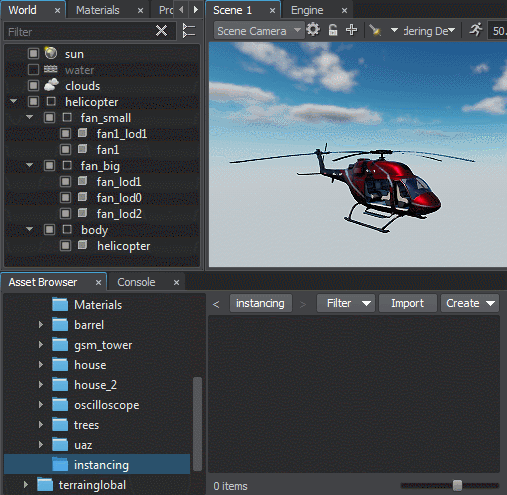
To learn more about creating Node References and managing them please follow the link below:Чтобы узнать больше о создании Node References и управлении ими, перейдите по ссылке ниже:
- Instancing Nodes. Создание экземпляров узлов .
- Video tutorial: Instancing NodesВидеоурок: Создание экземпляров узлов
How to Collaborate?Организация совместной работы#
Unreal Editor provides the Source Control feature out of the box. Also, its Multi-User Editing workflow is built on a server-client model, supporting a number of sessions inside a shared environment for collaborative work.Unreal Editor предоставляет возможность Source Control из коробки. Кроме того, его рабочий процесс многопользовательского редактирования построен на модели сервер-клиент, поддерживая ряд сеансов в общей среде для совместной работы.
In UNIGINE, all native file formats are text-based by default, so you can use any VCS you are used to and merge worlds, nodes and other assets. You can extend the file system to keep the shared assets by using Mount Points. Also, a normal workflow is to split work of different team members using separate Node Layers, so there will be no need to match the conflicted files when merging the project modifications.В UNIGINE все собственные форматы файлов по умолчанию основаны на тексте, поэтому вы можете использовать любую VCS , к которой вы привыкли, и объединять миры, узлы и другие ресурсы. Вы можете расширить файловую систему, чтобы сохранить общие ресурсы, используя точки монтирования . Кроме того, обычным рабочим процессом является разделение работы разных членов команды с использованием отдельного Node Layers, поэтому не будет необходимости сопоставлять конфликтующие файлы при объединении изменений проекта.
Check out the related article for more details:Ознакомьтесь с соответствующей статьей для получения более подробной информации:
- Configuring Version ControlНастройка контроля версий
CamerasКамеры#
Cameras, the entities essential for rendering, are treated slightly differently in both engines. Камеры , сущности, необходимые для рендеринга, обрабатываются в обоих движках немного по-разному.
In UE4, the CameraComponent is responsible for capturing a view and sending it to render. You usually set a Pawn actor with a CameraComponent attached as a default character by specifying it in a GameMode settings.В UE4 CameraComponent отвечает за захват представления и отправку его на рендеринг. Обычно вы устанавливаете актера Pawn с присоединенным CameraComponent в качестве символа по умолчанию, указав его в настройках GameMode.
In UNIGINE, the Camera is a rendering-related object and implemented by the Player nodes in the world. There are several player types with different behaviour provided in order to simplify creation of the most commonly used cameras controlled via the input devices (keyboard, mouse, joystick):В UNIGINE Camera - это объект, связанный с рендерингом, который реализуется узлами Player в мире. Предусмотрено несколько типов игроков с различным поведением, чтобы упростить создание наиболее часто используемых камер, управляемых через устройства ввода (клавиатура, мышь, джойстик):
- Dummy is a simple camera wrapper. You can use it for static cameras or enhance with custom logic. Dummy - это простая оболочка камеры. Вы можете использовать ее для статических камер или расширить ее функционал с помощью пользовательской логики.
- Spectator is a free flying camera. Spectator - это свободно летающая камера.
- Persecutor is a flying camera that has the target and orbits it at the specified distance. It is a ready-to-use simple solution for a third-person camera. Persecutor - это летающая камера, которая имеет цель и вращается вокруг нее на указанном расстоянии. Это готовое простое решение для камеры от третьего лица.
- Actor is a player that is capable of providing physical interaction with scenery. It has a rigid physical body, which is approximated with a capsule shape. It is a ready-to-use simple solution for a first-person character. Actor - это игрок, способный обеспечить физическое взаимодействие с декорациями. Он имеет твердое физическое тело, которое приближается к форме капсулы. Это готовое к использованию простое решение для персонажа от первого лица.
Only one player can be rendered into the viewport at a moment. To switch between cameras in the Editor Viewport of the UnigineEditor, use the Camera panel:Одновременно во вьюпорте может отображаться только один player. Для переключения между камерами в окне просмотра Editor UnigineEditor используйте панель Camera:

By checking the Main Player flag of a player you set the default player, which will be rendered in the Editor's Engine viewport and on world startup when running the application.Проверяя флаг Main Player игрока, вы устанавливаете проигрыватель по умолчанию, который будет отображаться в окне просмотра Engine редактора и при запуске мира при запуске приложения.
Project SettingsНастройки проекта#
Overall project settings adjustment in Unreal Editor is usually done via the Project Settings window. The Audio, Rendering, Physics, Input levels and other settings affect the whole project. Also, the World Settings panel provides settings for the current Level.Общая настройка параметров проекта в Unreal Editor обычно выполняется через окно Project Settings. Аудио, рендеринг, физика, уровни ввода и другие параметры влияют на весь проект. Также панель World Settings предоставляет настройки для текущего Уровня.
In UNIGINE, the Common Settings and Preferences are available via Windows -> Settings menu at the Runtime section. The World settings are set for each world separately.В UNIGINE общие настройки и предпочтения доступны через меню Windows -> Settings в разделе Runtime. Настройки World устанавливаются для каждого мира отдельно.
Saved ConfigurationsСохраненные конфигурации#
You use Export and Import buttons in the project settings of the Unreal Editor to save the values of the settings to an external configuration file (.ini) and load them when necessary.Вы используете кнопки Экспорт и Импорт в настройках проекта Unreal Editor, чтобы сохранить значения настроек во внешний файл конфигурации (.ini) и загрузить их при необходимости.

In UNIGINE, you can save and load general physics, sound and render settings the same way. The presets are stored as assets with the *.physics, *.sound and *.render extensions respectively. Use Load and Save .* asset buttons of the Settings window to work with presets of the corresponding settings section.В UNIGINE вы можете сохранять и загружать общие настройки физики, звука и рендеринга таким же образом. Пресеты хранятся как ассеты с расширениями *.physics, *.sound и *.render соответственно. Для работы с пресетами соответствующего раздела настроек используйте кнопки Load и Save .* asset окна Settings.

Saved assets appear in the Asset Browser. You can load the render settings by double-clicking the required .render asset.Сохраненные ассеты появятся в браузере ассетов. Вы можете загрузить настройки рендеринга, дважды щелкнув необходимый ассет .render.

Presets are not an Editor-only feature in UNIGINE. You can use Physics, Sound and Render classes to manage presets for corresponding settings, for example, to switch between quality levels at run time.Предустановки не доступны только для редактора в UNIGINE. Вы можете использовать Physics , Sound и Render классы для управления предустановками для соответствующих настроек, например, для переключения между уровнями качества во время выполнения.
GraphicsГрафика#
In UE4, settings for graphics quality are mostly gathered in the Engine - Rendering section.В UE4 настройки качества графики в основном собраны в разделе Engine - Rendering.
In UNIGINE, the rendering settings of the world can be found in the Render section of the Settings window. You can also toggle on and off the most common render features by using the Rendering menu:В UNIGINE настройки рендеринга мира можно найти в разделе Render окна Settings. Вы также можете включать и выключать наиболее распространенные функции рендеринга с помощью меню Rendering:
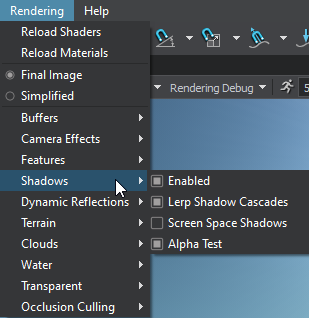
There is no platform-dependent quiality adjustments in UNIGINE, you should write your own logic to control the quality levels. You can use Render Presets for this purpose.В UNIGINE нет настроек качества, зависящих от платформы, вы должны написать свою собственную логику для контроля уровня качества. Для этой цели вы можете использовать Presets Render Presets .
Deferred and Forward ShadingОтложенное и прямое затенение#
By default, Unreal Engine uses a Deferred Renderer. You can switch to Forward Shading Renderer, which would provide better performance in some cases, in the Project Setting -> Rendering section.По умолчанию Unreal Engine использует отложенный рендерер . Вы можете переключиться на Forward Shading Renderer , который в некоторых случаях обеспечит лучшую производительность, в разделе Project Setting -> Rendering.
UNIGINE has the fixed Rendering Sequence represented by a combination of a full deferred renderer with forward rendering techniques:UNIGINE имеет фиксированную последовательность рендеринга , представленную комбинацией полного отложенного рендерера с методами прямого рендеринга:
- All opaque (non-transparent) geometry is rendered in the deferred pass.Вся непрозрачная (непрозрачная) геометрия визуализируется в отложенном проходе.
- Transparent geometry is rendered in the forward pass. Прозрачная геометрия отображается в прямом проходе.
You can reduce computational load by skipping certain rendering stages. Watch the dedicated video tutorial on using the Microprofile tool to optimize rendering:Вы можете снизить вычислительную нагрузку, пропустив определенные этапы рендеринга. Посмотрите специальный видеоурок по использованию инструмента Microprofile для оптимизации рендеринга:
- Video tutorial: Microprofile for ArtistsВидеоурок: Microprofile для художников
Post ProcessingПостобработка#
Unreal Engine uses PostProcessVolume to define the volumes where post-processing parameters and effects are locally (or globally) overridden, parameters are blended using linear interpolation. In UNIGINE, you will have to write your own logic to smoothly interpolate between settings at different spaces (if such a requirement appears).Unreal Engine использует PostProcessVolume для определения объемов, в которых параметры и эффекты постобработки переопределяются локально (или глобально), параметры смешиваются с использованием линейной интерполяции. В UNIGINE вам нужно будет написать свою собственную логику для плавной интерполяции между настройками в разных местах (если появляется такое требование).
This section lists all common UE4 post-processing techniques that can be achieved in UNIGINE as well.В этом разделе перечислены все распространенные методы постобработки UE4, которые также могут быть реализованы в UNIGINE.
| Unreal Engine | UNIGINE |
|---|---|
Anti-aliasing methods:
|
Anti-aliasing methods: |
| Eye Adaptation (Auto-Exposure) | Camera Effects: |
| Bloom | |
| Filmic Tonemapper | |
| White Balance | |
| Dirt Mask | |
| Lens Flare | |
| Color Grading LUT (Lookup Texture) | |
| Depth of Field | Depth of Field |
| Post Process Materials | Postprocess Materials |
| Chromatic Aberration | The post_color_correction postprocess material |
| Film Grain | |
| Screen Space Reflections | SSR |
| Screen-Space Ambient Occlusion | Screen-Space Ambient Occlusion |
| Screen Space Global Illumination | SSRTGI |
| Contact Shadows | Screen Space Shadows |
| Motion Blur | Motion Blur |
| Screen Percentage | Supersampling |
What's Next?Что дальше?#
Where to go from here? Куда идти дальше?
Make sure you don't miss the subtopics of this guide:Не забудьте прочитать другие темы этого руководства:
Thank you for reading the guide! You can proceed to the following sections for further learning:Спасибо, что прочитали руководство! Вы можете перейти к следующим разделам для дальнейшего изучения:
Информация, представленная на данной странице, актуальна для версии UNIGINE 2.18.1 SDK.



